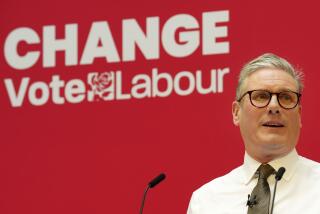Gaffes Imperil Tory Campaign Edge : Thatcher on the Defensive as Labor Party Seizes Initiative
- Share via
LONDON — The first week of Britain’s 3 1/2-week general election campaign yielded growing signs that Margaret Thatcher faces a far tougher struggle than expected in her bid to become the first British prime minister to win a third term in this century.
Since campaigning officially kicked off last Monday, with Thatcher’s Conservative Party holding a comfortable lead of about 10 percentage points in most major national opinion polls, a series of gaffes and spotty organization have kept her almost constantly on the defensive.
By contrast, the main opposition Labor Party has astonished political observers by launching one of the smoothest campaigns in recent memory, carefully stage-managed for television, and carrying a powerful appeal to moderate voters.
Election day is June 11.
Tory Initiative Was Expected
When Thatcher announced the election earlier this month, it was widely expected that the better-financed Tories would immediately seize the initiative from Labor, which had seemed preoccupied by internal quarrels.
Many pundits had predicted that the only real battle would be the one for second place between a disorganized Labor Party and an increasingly appealing centrist alternative offered by an alliance of the Liberals and Social Democrats.
Instead, the alliance has slumped badly and Labor appears to have awakened from a prolonged slumber to present a viable challenge to Thatcher’s government.
A series of polls published Sunday indicated that in spite of the unexpected start to the campaign, the Conservatives still hold leads over Labor, varying from 7 to 13 percentage points. But Labor has already edged upwards in some polls, and few expect today’s apparently comfortable Tory lead to hold up if the Conservatives continue to stumble.
Flickers of Doubt
While the Tories would have to lose more than 70 seats in the 650-seat House of Commons before Thatcher would be forced to relinquish her majority, flickers of doubt have begun to appear.
“The election is more open than it appeared,” said a weekend editorial in the London Independent, one of the few national newspapers with no clear political bias.
Some political analysts note that as recently as last autumn, Labor led the Conservatives in the opinion polls and that British general elections have a history of volatility.
In 1970, Labor Prime Minister Harold Wilson had a comfortable lead in the polls in the final week of the campaign, yet lost to Edward Heath.
The 1987 Tory campaign started badly and has yet to recover.
While Thatcher launched the Conservative election program in a drab room so small that half the press covering the event had to sit next door, Labor chose the main hall of a modern London conference center, then fitted it with dramatic television backdrops.
Brief, Cogent and Mild
The program Labor presented was also uncharacteristically brief, cogent and mild in tone.
While Thatcher had hoped to attack Labor’s controversial anti-nuclear defense policies and dwell on the potential power of Labor’s radical left fringe, she has been on the defensive since the campaign began.
When Labor publicized optimistic Tory statements made four years ago on lowering unemployment, the Tories decided to challenge whether the statement had actually been made.
As a result, the issue of high unemployment that the Conservatives had hoped to play down ended up dominating the news for two days.
Worse for the Conservatives, a Labor Party office worker dug up a tape-recording confirming the spirit, if not the letter, of the optimistic Tory statement.
Conservative hopes of selling an education reform package as the antidote to the present turmoil in the state-run school system have also begun to unravel.
Conflicting Versions
Last Friday, Thatcher and her education secretary, Kenneth Baker, gave two conflicting versions of the Conservative package, one of which raised the prospect that parents might have to pay fees for state schooling. The ensuing confusion raised doubts about whether the Tories, in fact, have an answer to a problem that worries a large number of voters.
Sunday, Thatcher was still attempting to clear the confusion while Labor’s education spokesman, John Radice, charged that the Tory initiative was little more than a series of contradictions.
“Seldom has a political bubble been so quickly burst,” he said confidently.
Labor has also skillfully marketed its leader, Neil Kinnock, opting for high-quality television exposure rather than stressing the town square rallies that have traditionally dictated the rhythm of British general elections.
On Friday, Kinnock met only a handful of voters in a day that included opening a park and visiting a farm in Wales. Both engagements, however, presented good visual backdrops to stress his policies.
Slick Piece of Television
A 10-minute Labor political broadcast aired late last week aimed at boosting Kinnock’s image was one of the slickest pieces of television political advertising ever seen in Britain.
Put together by Hugh Hudson, the Oscar-winning director of “Chariots of Fire,” the broadcast countered Kinnock’s image as a weak leader and stressed his concern for Britain’s less fortunate citizens--an area where Thatcher is considered vulnerable.
The three major parties each receive five free 10-minute segments of television time to present their policies during the campaign.
Meanwhile, the issues of Labor’s radical left and the party’s controversial defense policies, which include scrapping Britain’s modest nuclear deterrent and demanding the withdrawal of American nuclear forces stationed here since the 1950s, have played only at the fringes of the campaign.
Despite Labor’s impressive start, however, political observers believe it will require several more Conservative slip-ups to place Thatcher in real danger.
They noted that even the most unfavorable national polls published Sunday would give her a majority of about 40 seats in the 650-seat House.
More to Read
Sign up for Essential California
The most important California stories and recommendations in your inbox every morning.
You may occasionally receive promotional content from the Los Angeles Times.










